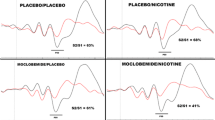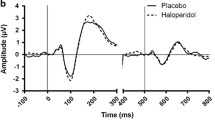Abstract
Rationale
Sensory gating is an adaptive mechanism of the brain to prevent overstimulation. Patients suffering from clinical disorders such as Alzheimer’s disease or schizophrenia exhibit a deficit in gating, which indicates not only an impairment in basic information processing that might contribute to the cognitive problems seen in these patients. Phosphodiesterase type 5 inhibitors (PDE5-Is) have been shown to improve cognition in rodents in various behavioural tasks and might consequently be an interesting target for cognition enhancement. However, the effects of PDE5-Is on sensory gating are not known yet.
Objectives
This work aims to study the effects of PDE5 inhibition on auditory sensory gating in rats and humans.
Methods
In the rat study, vehicle or 0.3–3 mg/kg of the PDE5-I vardenafil was given orally 30 min before testing and electrode locations were the vertex, hippocampus and the striatum. The human subjects received placebo, 10–20 mg vardenafil 85 min before testing and sensory gating was measured at the cortex (Fz, Fcz and Cz) electrodes.
Results
Significant gating was only found for the N1 component in rats while all three peaks P1, N1 and P2 showed gating in humans, i.e. the response to the second sound click was decreased as compared with the first for these deflections. Administration of vardenafil did neither have an effect on sensory gating in rats nor in humans.
Conclusions
These findings imply that positive effects of PDE5 inhibition on cognition are not mediated by more early phases of information processing.




Similar content being viewed by others

References
Adler LE, Pachtman E, Franks RD, Pecevich M, Waldo MC, Freedman R (1982) Neurophysiological evidence for a defect in neuronal mechanisms involved in sensory gating in schizophrenia. Biol Psychiatry 17:639–654
Akhondzadeh S, Ghayyoumi R, Rezaei F, Salehi B, Modabbernia AH, Maroufi A, Esfandiari GR, Naderi M, Ghebleh F, Tabrizi M, Rezazadeh SA (2011) Sildenafil adjunctive therapy to risperidone in the treatment of the negative symptoms of schizophrenia: a double-blind randomized placebo-controlled trial. Psychopharmacol (Berl) 213:809–815
Ally BA, Jones GE, Cole JA, Budson AE (2006) Sensory gating in patients with Alzheimer's disease and their biological children. Am J Alzheimers Dis Other Demen 21:439–447
Bender AT, Beavo JA (2006) Cyclic nucleotide phosphodiesterases: molecular regulation to clinical use. Pharmacol Rev 58:488–520
Boutros NN, Brockhaus-Dumke A, Gjini K, Vedeniapin A, Elfakhani M, Burroughs S, Keshavan M (2009) Sensory-gating deficit of the N100 mid-latency auditory evoked potential in medicated schizophrenia patients. Schizophr Res 113:339–346
Broberg BV, Oranje B, Glenthoj BY, Fejgin K, Plath N, Bastlund JF (2010) Assessment of auditory sensory processing in a neurodevelopmental animal model of schizophrenia—gating of auditory-evoked potentials and prepulse inhibition. Behav Brain Res 213:142–147
Cadenhead KS, Light GA, Shafer KM, Braff DL (2005) P50 suppression in individuals at risk for schizophrenia: the convergence of clinical, familial, and vulnerability marker risk assessment. Biol Psychiatry 57:1504–1509
Chang WP, Arfken CL, Sangal MP, Boutros NN (2011) Probing the relative contribution of the first and second responses to sensory gating indices: a meta-analysis. Psychophysiology 48:980–992
Cromwell HC, Mears RP, Wan L, Boutros NN (2008) Sensory gating: a translational effort from basic to clinical science. Clin EEG Neurosci 39:69–72
Dalecki A, Croft RJ, Johnstone SJ (2011) An evaluation of P50 paired-click methodologies. Psychophysiology 48:1692–1700
Devan BD, Bowker JL, Duffy KB, Bharati IS, Jimenez M, Sierra-Mercado D Jr, Nelson CM, Spangler EL, Ingram DK (2006) Phosphodiesterase inhibition by sildenafil citrate attenuates a maze learning impairment in rats induced by nitric oxide synthase inhibition. Psychopharmacol (Berl) 183:439–445
Devan BD, Pistell PJ, Daffin LW Jr, Nelson CM, Duffy KB, Bowker JL, Bharati IS, Sierra-Mercado D, Spangler EL, Ingram DK (2007) Sildenafil citrate attenuates a complex maze impairment induced by intracerebroventricular infusion of the NOS inhibitor N(omega)-nitro-l-arginine methyl ester. Eur J Pharmacol 563:134–140
EMEA (2008) European Public Assessment Report; revision 6. Available from www.emea.europa.eu
Goff DC, Cather C, Freudenreich O, Henderson DC, Evins AE, Culhane MA, Walsh JP (2009) A placebo-controlled study of sildenafil effects on cognition in schizophrenia. Psychopharmacol (Berl) 202:411–417
Grass H, Klotz T, Fathian-Sabet B, Berghaus G, Engelmann U, Kaferstein H (2001) Sildenafil (Viagra): is there an influence on psychological performance? Int Urol Nephrol 32:409–412
Hajos M (2006) Targeting information-processing deficit in schizophrenia: a novel approach to psychotherapeutic drug discovery. Trends Pharmacol Sci 27:391–398
Halene TB, Siegel SJ (2008) Antipsychotic-like properties of PDE4 inhibitors—evaluation of RO-20-1724 with auditory event related potentials and prepulse inhibition of startle. J Pharmacol Exp Ther 326:230–239
Hitchcock SA, Pennington LD (2006) Structure–brain exposure relationships. J Med Chem 49:7559–7583
Jasper H (1958) The ten–twenty electrode system of the international federation. Electroencephalogr Clin Neurophysiol 10:371–375
Javitt DC (2009) Sensory processing in schizophrenia: neither simple nor intact. Schizophr Bull 35:1059–1064
Jessen F, Kucharski C, Fries T, Papassotiropoulos A, Hoenig K, Maier W, Heun R (2001) Sensory gating deficit expressed by a disturbed suppression of the P50 event-related potential in patients with Alzheimer's disease. Am J Psychiatry 158:1319–1321
Lijffijt M, Moeller FG, Boutros NN, Burroughs S, Lane SD, Steinberg JL, Swann AC (2009) The role of age, gender, education, and intelligence in P50, N100, and P200 auditory sensory gating. J Psychophysiol 23:52–62
Maxwell CR, Liang Y, Weightman BD, Kanes SJ, Abel T, Gur RE, Turetsky BI, Bilker WB, Lenox RH, Siegel SJ (2004) Effects of chronic olanzapine and haloperidol differ on the mouse N1 auditory evoked potential. Neuropsychopharmacology 29:739–746
Mears RP, Klein AC, Cromwell HC (2006) Auditory inhibitory gating in medial prefrontal cortex: single unit and local field potential analysis. Neuroscience 141:47–65
Mears RP, Boutros NN, Cromwell HC (2009) Reduction of prelimbic inhibitory gating of auditory evoked potentials after fear conditioning. Behav Neurosci 123:315–327
Miyazato H, Skinner RD, Garcia-Rill E (1999) Neurochemical modulation of the P13 midlatency auditory evoked potential in the rat. Neuroscience 92:911–920
Paxinos G, Watson C (1998) The rat brain in stereotaxic coordinates, 4th edn. Academic, New York
Prickaerts J, de Vente J, Honig W, Steinbusch HW, Blokland A (2002a) cGMP, but not cAMP, in rat hippocampus is involved in early stages of object memory consolidation. Eur J Pharmacol 436:83–87
Prickaerts J, van Staveren WC, Sik A, Markerink-van Ittersum M, Niewohner U, van der Staay FJ, Blokland A, de Vente J (2002b) Effects of two selective phosphodiesterase type 5 inhibitors, sildenafil and vardenafil, on object recognition memory and hippocampal cyclic GMP levels in the rat. Neuroscience 113:351–361
Prickaerts J, Sik A, van Staveren WC, Koopmans G, Steinbusch HW, van der Staay FJ, de Vente J, Blokland A (2004) Phosphodiesterase type 5 inhibition improves early memory consolidation of object information. Neurochem Int 45:915–928
Reagan-Shaw S, Nihal M, Ahmad N (2008) Dose translation from animal to human studies revisited. FASEB J 22:659–661
Reneerkens OA, Rutten K, Steinbusch HW, Blokland A, Prickaerts J (2009) Selective phosphodiesterase inhibitors: a promising target for cognition enhancement. Psychopharmacol (Berl) 202:419–443
Reneerkens OA, Rutten K, Akkerman S, Blokland A, Shaffer CL, Menniti FS, Steinbusch HW, Prickaerts J (2012) Phosphodiesterase type 5 (PDE5) inhibition improves object recognition memory: indications for central and peripheral mechanisms. Neurobiol Learn Mem 97:370–379
Rutten K, Prickaerts J, Hendrix M, van der Staay FJ, Sik A, Blokland A (2007) Time-dependent involvement of cAMP and cGMP in consolidation of object memory: studies using selective phosphodiesterase type 2, 4 and 5 inhibitors. Eur J Pharmacol 558:107–112
Rutten K, Basile JL, Prickaerts J, Blokland A, Vivian JA (2008) Selective PDE inhibitors rolipram and sildenafil improve object retrieval performance in adult cynomolgus macaques. Psychopharmacol (Berl) 196:643–648
Rutten K, Van Donkelaar EL, Ferrington L, Blokland A, Bollen E, Steinbusch HW, Kelly PA, Prickaerts JH (2009) Phosphodiesterase inhibitors enhance object memory independent of cerebral blood flow and glucose utilization in rats. Neuropsychopharmacology 34:1914–1925
Sambeth A, Maes JH, Van Luijtelaar G, Molenkamp IB, Jongsma ML, Van Rijn CM (2003) Auditory event-related potentials in humans and rats: effects of task manipulation. Psychophysiology 40:60–68
Sambeth A, Riedel WJ, Smits LT, Blokland A (2007) Cholinergic drugs affect novel object recognition in rats: relation with hippocampal EEG? Eur J Pharmacol 572:151–159
Schultheiss D, Muller SV, Nager W, Stief CG, Schlote N, Jonas U, Asvestis C, Johannes S, Munte TF (2001) Central effects of sildenafil (Viagra) on auditory selective attention and verbal recognition memory in humans: a study with event-related brain potentials. World J Urol 19:46–50
Shim YS, Pae CU, Kim SW, Kim HW, Kim JC, Koh JS (2011) Effects of repeated dosing with udenafil (Zydena) on cognition, somatization and erection in patients with erectile dysfunction: a pilot study. Int J Impot Res 23:109–114
van Donkelaar EL, Rutten K, Blokland A, Akkerman S, Steinbusch HW, Prickaerts J (2008) Phosphodiesterase 2 and 5 inhibition attenuates the object memory deficit induced by acute tryptophan depletion. Eur J Pharmacol 600:98–104
Wan L, Crawford HJ, Boutros N (2006) P50 sensory gating: impact of high vs. low schizotypal personality and smoking status. Int J Psychophysiol 60:1–9
Wan L, Crawford HJ, Boutros N (2007) Early and late auditory sensory gating: moderating influences from schizotypal personality, tobacco smoking status, and acute smoking. Psychiatry Res 151:11–20
Zhou D, Ma Y, Liu N, Chen L, He M, Miao Y (2008) Influence of physical parameters of sound on the sensory gating effects of N40 in rats. Neurosci Lett 432:100–104
Conflicts of interest
None
Author information
Authors and Affiliations
Corresponding author
Rights and permissions
About this article
Cite this article
Reneerkens, O.A.H., Sambeth, A., Van Duinen, M.A. et al. The PDE5 inhibitor vardenafil does not affect auditory sensory gating in rats and humans. Psychopharmacology 225, 303–312 (2013). https://doi.org/10.1007/s00213-012-2817-7
Received:
Accepted:
Published:
Issue Date:
DOI: https://doi.org/10.1007/s00213-012-2817-7



